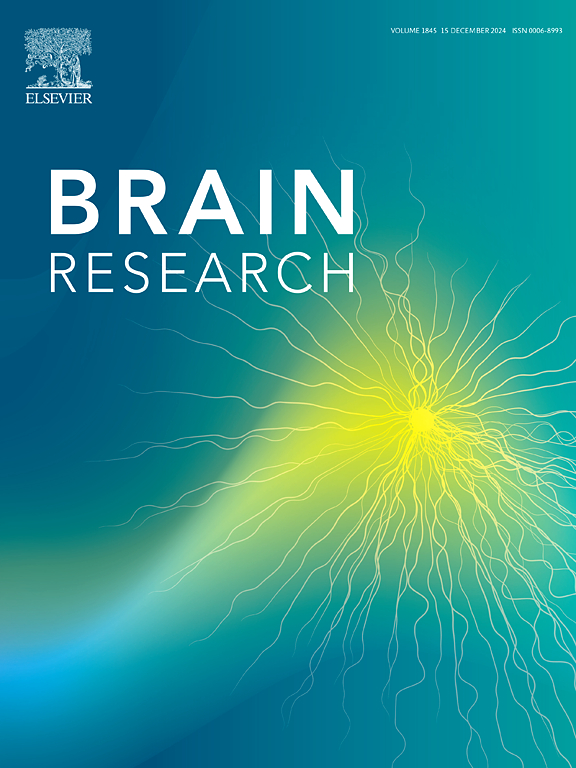亲环蛋白D敲除/敲除通过抑制STAT1促进小胶质细胞M2极化,减轻新生儿白质损伤的神经炎症。
IF 2.7
4区 医学
Q3 NEUROSCIENCES
引用次数: 0
摘要
小胶质细胞的激活与神经炎症和新生儿白质损伤(WMI)的病理生理密切相关。亲环蛋白D (Cyclophilin D, CypD)是一种基质亲环蛋白,是线粒体通透性过渡孔的重要调节因子之一。目前,CypD已被发现具有调节炎症的功能。然而,在新生儿WMI的情况下,其对小胶质细胞的影响尚不清楚。在我们的研究中,CypD抑制改善了新生WMI小鼠和氧葡萄糖剥夺/再灌注(OGD/R)诱导的BV2小胶质细胞的小胶质细胞活化,降低了促炎因子水平,增加了抗炎因子水平。CypD敲除促进小鼠缺氧缺血性损伤后髓鞘形成并恢复神经功能。此外,CypD敲低可减轻BV2小胶质细胞线粒体功能障碍。RNA-Seq显示CypD抑制下调STAT1。Western blotting结果证实CypD抑制显著下调STAT1的磷酸化水平。我们的研究揭示了CypD抑制对小胶质细胞神经炎症和线粒体功能的保护作用。靶向小胶质细胞中CypD的表达可能是新生儿WMI的潜在治疗选择。本文章由计算机程序翻译,如有差异,请以英文原文为准。

Cyclophilin D knockdown/knockout promotes microglia M2 polarization by inhibiting STAT1 to alleviate neuroinflammation in neonatal white matter injury
The activation of microglia cells is intimately associated with the pathophysiology of neuroinflammation and neonatal white matter injury (WMI). Cyclophilin D (CypD), a matrix cyclophilin, is known to be one of the important regulators of mitochondrial permeability transition pore. Currently, CypD has been discovered the function of regulating inflammation. However, its impact on microglia in the context of neonatal WMI remains unclear. In our study, CypD inhibition ameliorated microglia activation, decreased pro-inflammatory factor levels, and increased anti-inflammatory factor levels in both neonatal WMI mice and oxygen glucose deprivation/reperfusion (OGD/R)-induced BV2 microglial cells. CypD knockout promoted myelination and rescued neurological function in mice following hypoxic-ischemic injury. In addition, CypD knockdown alleviated mitochondrial dysfunction of BV2 microglial cells. RNA-Seq indicated that CypD inhibition downregulated STAT1. Western blotting results verified that CypD inhibition significantly downregulated the phosphorylation level of STAT1. Our research revealed the protective role of CypD inhibition in neuroinflammation and mitochondrial function of microglia. Targeting CypD expression in microglia may be a potential therapeutic option for neonatal WMI.
求助全文
通过发布文献求助,成功后即可免费获取论文全文。
去求助
来源期刊

Brain Research
医学-神经科学
CiteScore
5.90
自引率
3.40%
发文量
268
审稿时长
47 days
期刊介绍:
An international multidisciplinary journal devoted to fundamental research in the brain sciences.
Brain Research publishes papers reporting interdisciplinary investigations of nervous system structure and function that are of general interest to the international community of neuroscientists. As is evident from the journals name, its scope is broad, ranging from cellular and molecular studies through systems neuroscience, cognition and disease. Invited reviews are also published; suggestions for and inquiries about potential reviews are welcomed.
With the appearance of the final issue of the 2011 subscription, Vol. 67/1-2 (24 June 2011), Brain Research Reviews has ceased publication as a distinct journal separate from Brain Research. Review articles accepted for Brain Research are now published in that journal.
 求助内容:
求助内容: 应助结果提醒方式:
应助结果提醒方式:


